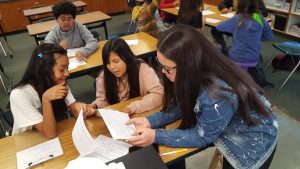Real Change from Students

To view the photo-rich magazine version, click here.
Originally appears in the Spring 2020 issue.
By Melanie P. Master
Now more than ever, teachers are in a position to empower students to solve pressing environmental issues that threaten the health of our planet. Standard ESS3-3 of the Next Generation Science Standards (NGSS) for K–12 classes in the United States calls on students to design a solution to an environmental problem, but why stop at just designing a solution? This standard can be leveraged to actually have students change environmental behaviors in their community through a process known as Community-Based Social Marketing (CBSM). CBSM is a research-based method created by social psychologist Dr. McKenzie-Mohr that creates behavior changes within a community by combining social psychology and environmental science principles.1 In essence, CBSM influences the collective mindset of a community to condition them into changing their behaviors.
Before using evidence-based CBSM to solve behavioral problems, my students’ environmental solutions were often based on best guesses for which strategies would change behaviors of students, such as implementing informational poster campaigns about the effects of litter or installing basketball hoops over trash cans to encourage the throwing away of trash. These types of solutions that ‘feel right’ often don’t work, and students know it. But once my students began using CBSM to solve environmental issues, there was a rise in their feelings of competence, a key factor that increases the likelihood environmental problems will actually be solved.2
A student-driven CBSM campaign consists of five sequential steps: 1) selecting the target behavior; 2) determining barriers and benefits of doing the behavior; 3) choosing strategies to encourage the behavior; 4) collecting stakeholder feedback on strategies, piloting; and finally, 5) broadscale implementation. To carry out a successful CBSM campaign from start to finish is an ambitious challenge for both the teacher and students, and it can take multiple months to complete depending on the depth and complexity of the campaign. The process was originally designed to be carried out by professionals, so it requires some tweaking to be executed with middle school students.
This content is restricted to subscribers only.
If you are not yet a subscriber, please consider taking out a subscription here.
If you are an existing subscriber, kindly log in or contact us at info@greenteacher.com for more information.





